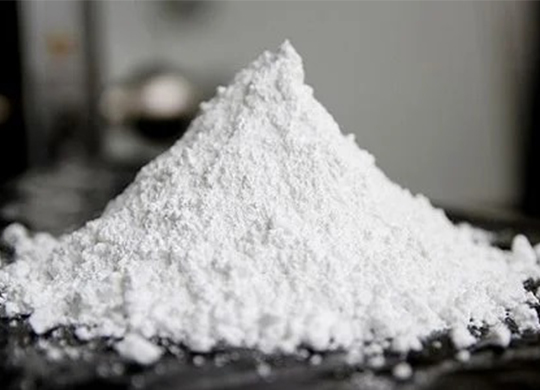

One innovative form of calcium carbonate is stearic acid coated calcium carbonate , which enhances its properties and expands its applications. In this article, we will explore the features, benefits, and uses of stearic acid coated calcium carbonate, along with its production methods and market significance.
Typical Chemical & PHYSICAL Analysis
|
|
|
|---|---|
| CaCo3 | 98 ± 1 |
| MgCO3 | 2+1 |
| Al-silicate | < 1% |
| Fe2O3 | < 0.1% |
| Moisture | 0.2% (Ex works) |
|
|
|
|---|---|
| Sp.Gravity | 2.7 |
| Bulk Density | 950 gm/lit |
| Oil Absorption | 19% |
| PH of Sat Solution | 8.2 |
| Moisture | 0.2% (Ex works) |
| Particle Size | Average | Top Cut |
| Distribution | 3.0 M | 12 M |
Understanding Stearic Acid Coated Calcium Carbonate
Stearic acid coated calcium carbonate is produced by treating calcium carbonate with stearic acid, a saturated fatty acid found in animal and vegetable fats. This coating process improves the surface properties of calcium carbonate, making it more hydrophobic and facilitating its dispersion in non-polar solvents and various formulations.
The coating of stearic acid helps to reduce the agglomeration of calcium carbonate particles. This results in a finer, more uniform particle size, which is essential for achieving desired physical properties in end products. The hydrophobic nature of the coated calcium carbonate enhances its compatibility with hydrophobic matrices, making it an ideal filler for various applications.
Benefits of Stearic Acid Coated Calcium Carbonate
- Enhanced Dispersion: One of the primary advantages of stearic acid coated calcium carbonate is its improved dispersion in polymer matrices and other formulations. The hydrophobic nature of the coating allows for better mixing with non-polar solvents and resins, resulting in uniform distribution.
- Reduced Moisture Absorption: The coating provides a barrier against moisture, which is particularly beneficial in applications where water sensitivity is a concern. This property ensures that the coated calcium carbonate maintains its integrity and performance in humid conditions.
- Improved Mechanical Properties: Stearic acid coated calcium carbonate can enhance the mechanical properties of various materials. When used as a filler in plastics, for instance, it can improve tensile strength, impact resistance, and overall durability.
- Cost-Effectiveness: Using stearic acid coated calcium carbonate as a filler can reduce production costs. It allows manufacturers to substitute more expensive materials while maintaining product quality, making it an attractive option in competitive markets.
- Non-Toxic and Eco-Friendly: Stearic acid is a naturally occurring fatty acid that is generally recognized as safe (GRAS) for use in food and pharmaceuticals. This makes stearic acid coated calcium carbonate a non-toxic and environmentally friendly alternative for various applications.
Production Methods
The production of stearic acid coated calcium carbonate typically involves the following steps:
- Selection of Calcium Carbonate: High-purity calcium carbonate is chosen as the base material. It is essential to ensure that the starting material meets the required specifications for the intended application.
- Coating Process: The calcium carbonate is treated with stearic acid in a controlled environment. The coating process can be conducted using methods like wet mixing or spray drying, depending on the desired particle size and distribution.
- Drying and Milling: After the coating process, the stearic acid coated calcium carbonate is dried and milled to achieve the desired particle size. This step ensures that the final product is free-flowing and ready for use.
- Quality Control: The coated calcium carbonate undergoes rigorous quality control testing to ensure that it meets industry standards and specifications. This includes assessments of particle size, surface area, and moisture content.
Applications of Stearic Acid Coated Calcium Carbonate
Stearic acid coated calcium carbonate finds applications in various industries, including:
- Plastics and Polymers: Used as a filler in plastic formulations, it enhances the mechanical properties of the end products while improving processability.
- Paints and Coatings: The coated calcium carbonate is utilized in paints and coatings to improve gloss, opacity, and durability.
- Rubber Industry: It serves as a reinforcing agent in rubber formulations, enhancing strength and elasticity.
- Pharmaceuticals: Stearic acid coated calcium carbonate is used as a filler in tablets and capsules, aiding in the formulation process.
- Cosmetics: In the cosmetic industry, it is employed as a thickening agent and for its skin-conditioning properties.
Conclusion
Stearic acid coated calcium carbonate is a valuable material that enhances the properties of various products across multiple industries. Its ability to improve dispersion, reduce moisture absorption, and enhance mechanical properties makes it an ideal choice for manufacturers. With a focus on sustainability and cost-effectiveness, stearic acid coated calcium carbonate continues to play a significant role in the development of innovative materials and formulations. As industries evolve, the demand for high-quality coated calcium carbonate is likely to grow, further solidifying its importance in modern manufacturing processes.
Whether you’re in the plastics, paints, or pharmaceutical sector, incorporating stearic acid coated calcium carbonate can provide numerous advantages, making it a key ingredient for achieving product excellence. Companies like Airotech Minerals are dedicated to supplying high-quality stearic acid coated calcium carbonate, ensuring that manufacturers have access to the best materials for their specific needs.
